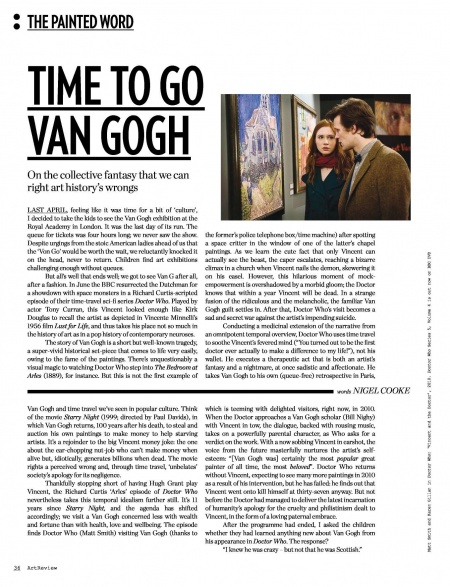Time to Go Van Gogh
- Publication: Art Review
- Date: October 2010
- Author: Nigel Cooke
- Page: 36
- Language: English
LAST APRIL feeling like it was time for a bit of 'culture', I decided to take the kids to see the Van Gogh exhibition at the Royal Academy in London. It was the last day of its run. The queue for tickets was four hours long; we never saw the show. Despite urgings from the stoic American ladies ahead of us that the 'Von Go' would be worth the wait, we reluctantly knocked it on the head, never to return. Children find art exhibitions challenging enough without queues.
But all's well that ends well; we got to see Van G after all, after a fashion. In June the BBC resurrected the Dutchman for a showdown with space monsters in a Richard Curtis-scripted episode of their time-travel sci-fi series Doctor Who. Played by actor Tony Curran, this Vincent looked enough like Kirk Douglas to recall the artist as depicted in Vincente Minnelli's 1956 film Lust for Life, and thus takes his place not so much in the history of art as in a pop history of contemporary neuroses.
The story of Van Gogh is a short but well-known tragedy, a super-vivid historical set-piece that comes to life very easily, owing to the fame of the paintings. There's unquestionably a visual magic to watching Doctor Who step into The Bedroom at Arles (ISSU), for instance. Hut this is not the first example of Van Gogh and time travel we've seen in popular culture. Think of the movie Starry Night (1999; directed by Paul Davids), in which Van Gogh returns, 100 years after his death, to steal and auction his own paintings to make money to help starving artists. It's a rejoinder to the big Vincent money joke: the one about the ear chopping nut-job who can't make money when alive but, idiotically, generates billions when dead. The movie rights a perceived wrong and, through time travel, 'unbelates' society's apology for its negligence.
Thankfully stopping short of having Hugh Grant play Vincent, the Richard Curtis 'Aries' episode of Doctor Who nevertheless lakes this temporal idealism further still. It's 11 years since Starry Night, and the agenda has shifted accordingly; we visit a Van Gogh concerned less with wealth and fortune than with health, low and wellbeing. The episode finds Doctor Who (Matt Smith) visiting Van Gogh (thanks to the former's police telephone box/time machine) after spotting a space critter in the window of one of the latter's chapel paintings. As we learn the cute fact that only Vincent can actually see the beast, the caper escalates, reaching a bizarre climax in a church when Vincent nails the demon, skewering it on his easel. However, this hilarious moment of mock-empowerment is overshadowed by a morbid gloom: the Doctor knows that within a year Vincent will be dead. In a strange fusion of the ridiculous and the melancholic, the familiar Van Gogh guilt settles in. After that, Doctor Who's visit becomes a sad and secret war against the artist's impending suicide.
Conducting a medicinal extension of the narrative from an omnipotent temporal overview, Doctor Who uses time travel to soothe Vincent's fevered mind ("You turned out to be the first doctor ever actually to make a difference to my life!"), not his wallet. He executes a therapeutic act that is both an artist's fantasy and a nightmare, at once sadistic and affectionate. He takes Van Gogh to his own (queue-free) retrospective in Paris, which is teeming with delighted visitors, right now, in 2010. When the Doctor approaches a Van Gogh scholar (Bill Nighy) with Vincent in tow, the dialogue, backed with rousing music, takes on a powerfully parental character, as Who asks for a verdict on the work. With a now sobbing Vincent in earshot, the voice from the future masterfully nurtures the artist's self-esteem: "[Van Gogh was] certainly the most popular great painter of all time, the most beloved". Doctor Who returns without Vincent, expecting to see many more paintings in 2010 as a result of his intervention, but he has failed: he finds out that Vincent went onto kill himself at thirty-seven anyway. Hut not before the Doctor had managed to deliver the latest incarnation of humanity's apology for the cruelty and philistinism dealt to Vincent, in the form of a loving paternal embrace.
After the programme had ended. I asked the children whether they had learned anything new about Van Gogh from his appearance in Doctor Who. The response?
"I knew he was crazy but not that he was Scottish."
ADDED MATERIAL
Matt Smith and Karen Gillan in Doctor Who: 'Vincent and the Doctor', 2010. Doctor Who Series 5, Volume 4 is out now on BBC DVD
Disclaimer: These citations are created on-the-fly using primitive parsing techniques. You should double-check all citations. Send feedback to whovian@cuttingsarchive.org
- APA 6th ed.: Cooke, Nigel (October 2010). Time to Go Van Gogh. Art Review p. 36.
- MLA 7th ed.: Cooke, Nigel. "Time to Go Van Gogh." Art Review [add city] October 2010, 36. Print.
- Chicago 15th ed.: Cooke, Nigel. "Time to Go Van Gogh." Art Review, edition, sec., October 2010
- Turabian: Cooke, Nigel. "Time to Go Van Gogh." Art Review, October 2010, section, 36 edition.
- Wikipedia (this article): <ref>{{cite news| title=Time to Go Van Gogh | url=http://cuttingsarchive.org/index.php/Time_to_Go_Van_Gogh | work=Art Review | pages=36 | date=October 2010 | via=Doctor Who Cuttings Archive | accessdate=20 April 2024 }}</ref>
- Wikipedia (this page): <ref>{{cite web | title=Time to Go Van Gogh | url=http://cuttingsarchive.org/index.php/Time_to_Go_Van_Gogh | work=Doctor Who Cuttings Archive | accessdate=20 April 2024}}</ref>
